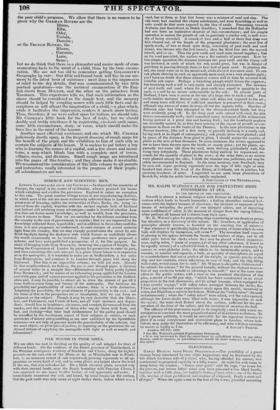OAK WOODS IN POOR SOILS.
WE are often too rash in deciding on the quality of soil adapted for trees of different kinds. On the confines of the Dutch province of Guelderland, in the Prussian contiguous territory of Guelders and Cleves, along the highest grounds on the east side of the Rhine, as far as Wiesbaden near to Frank- fort, is an immense extent of oak copsewood, growing vigorously to all ap pearance on every kind of soil, and in some places at a height above the level of the sea, that was unlooked for. On a bleak elevated Pain, covered only with short stunted heath, near the Dutch boundary with Prussian Cleves, I was surprised to see many healthy bushes of oak apparently self-sown. I immediately examined the soil, and found, by some breaks on the surface, that the peat earth was only seven or eight inches thick, below which was a
sand, but at three or four feet lower was a mixture of sand and clay. • The oak roots had reached this clayey substratum, and were flourishing as well as oaks could do that were exposed to the bite of cattle. Proceediog towards Arnheint and Amersfoort, in Dutch Guelders, I remarked that the Hollander had not been an inattentive observer of this circumstance ; and his simple operation to secure the growth of oak in precisely a similar soil, is well wor- thy of being recorded. A trench of two and a half or three feet deep was first cleared out, of the length of the proposed plantation ; the next line of spade-work, of two or three spits deep, consisting of peat earth and sand mixed, was thrown into the first trench ; then the third line into the second trench, and so on. Thus the peat earth and sand were mixed together ; but as the sand prevailed, the surface was a flat entirely of pure sand. Now by this simple operation the distance between the peat earth and the clayey soil was lessened, in each of which the oak would grow, but was in danger of perishing in passing through three or four feet of pure sand. In planting the oak, the roots were set in the mixed soil, while above it was mere sand. To see oak plants thriving in such an apparently mere sand, was a very singular sight; yet I have no doubt that these extensive wastes will in time be covered with valuable oak copse. Perhaps a trenching plough might lessen the expense; but trenching such a soil is very easily and cheaply executed. The mixture of peat earth and sand, where the peat earth was equal in quantity to the sand, is a soil by no means unfavourable to the oak. In several parts of Holland, I have seen it arrive at the size of a large tree in such a soil. Peat earth retains moisture beyond any other soil, when not exposed to the air ; and many trees will thrive if sufficient moisture is preserved at their roots ; although any excess of water destroys all but the aquatic tribe. Beeches of different sizes had been attempted in the above-described heath, but they were evidently going off. In the deep peat soils mixed with sand, the elm thrives uncommonly well; and I remarked many instances of the walnut-tree having arrived at a great size and bearing fruit ; but the Lombardy poplars are decidedly against it, as they have nothing of the vigour of growth so con- spicuous in those on the banks of the Thames. In the new plantations in the Nassau territory. (the soil a thin stony or gravelly inclining to a sandy soil, having rock at no depth of consequence,) oak plants alone were planted ; and by guess of the distance from plant to plant, I should assign the number of plants to the acre at four thousand. In some instances, the acorns appeared to me to have been thrown upon the heath, or scanty grass ; yet the plants, ap- parently two years old front the seed, were thriving particularly well, but rising very irregularly. These plantations being entirely for copsewood, ac- counts for the quantity of plants to the acre ; at the same time, as no nurses were planted among the oaks, I think the number was judicious, and maybe safely recommended in England. In the same territory, near Swalbach, may be seen oak copse growing vigorously over the tops of hills eight or nine hundred feet above the level of the Rhine, at Coblentz, not in patches, but covering hundreds of acres. I regretted to see some large plantations of Scotch fir, while the noble larch was totally neglected.
A SPECTATOR IN THE NETHERLANDS.


















 Previous page
Previous page